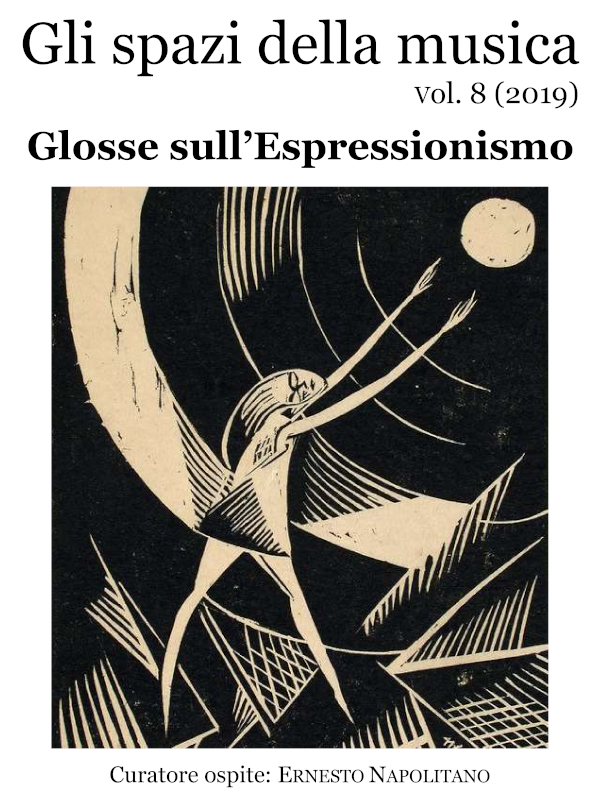Sull’incontro di Kandinskij e Schönberg, sotto il segno della “necessità interiore”
Parole chiave:
astrattismo, atonalità, sinestesia, Gesamtkunstwerk, Der Blaue ReiterAbstract
Il 2 gennaio 1911 Kandinskij ascoltò a Monaco un concerto con alcuni Lieder, i Quartetti op. 7 e op. 10 e i Klavierstücke di Schönberg, e pochi giorni dopo sentì il bisogno di scrivere al compositore (che non era presente al concerto): le lettere che si scambiarono negli anni 1911-14 formano il nucleo essenziale di un dialogo epistolare intorno alle affinità e alle convergenze che Kandinskij e Schönberg immediatamente avvertirono nella loro ricerca sotto il segno della “necessità interiore”, nella fase del primo astrattismo per l’uno e della sospensione della tonalità per l’altro. Senza indulgere ad approssimativi giochi di corrispondenze tra linguaggi e personalità differenti, è possibile tentare un confronto tra la sconvolta visione dello spazio pittorico del primo astrattismo di Kandinskij (uno spazio privato di un “centro” di riferimento) e il vertiginoso stravolgimento dello spazio sonoro che negli stessi anni produce in Schönberg l’abolizione di un centro tonale. Tra gli aspetti più interessanti dell’epistolario tra Schönberg e Kandinskij, che costituisce un contrappunto alle loro riflessioni teoriche e alle loro creazioni degli anni 1911-14, ci sono le ricerche sinestesiche che caratterizzano Il suono giallo e La mano felice, due esperienze teatrali diversissime e concepite in modo del tutto indipendente. E va ricordata la collaborazione del compositore all’almanacco Der Blaue Reiter con Herzgewächse su testo di Maeterlinck.
On the Meeting of Kandinskij and Schönberg, under the Sign of “Inner Need”
On January 2, 1911 Kandinskij attended concert in Münich with some Lieder, the Quartets op. 7 and op. 10 and the Klavierstücke by Schönberg – a few days later he felt the need to write to the composer (who didn’t attend the concert). The letters exchanged in the years 1911-14 form the essential nucleus of an epistolary dialogue about the affinities and convergences that Kandinsky and Schönberg immediately felt in their research under the sign of “inner need”, in the phase of the first abstractionism for one and the suspension of the tonality for the other. Without indulging in approximate games of correspondence between different languages and personalities, it is possible to attempt a comparison between the upset vision of the pictorial space of Kandinsky’s first abstractionism (a space deprived of a “centre” of reference) and the dizzying distortion of the sound space that in the same years produced in Schönberg the abolition of a tonal centre. Among the most interesting aspects of the correspondence between Schönberg and Kandinsky, which is a counterpoint to their theoretical reflections and their creations of the years 1911-14, there are the synaesthetic researches that characterize Der gelbe Klang and Die glückliche Hand, two very different theatrical experiences and conceived in a completely independent way. Schönberg also composed Herzgewächse on a text by Maeterlinck for the almanac Der Blaue Reiter.
##submission.downloads##
Pubblicato
Come citare
Fascicolo
Sezione
Licenza

Quest'opera è distribuita con licenza Creative Commons Attribuzione - Non commerciale - Non opere derivate 3.0 Unported. Tutti i diritti relativi a quanto pubblicato su «Gli spazi della musica», compreso il diritto di pubblicazione, restano di proprietà esclusiva degli autori.



